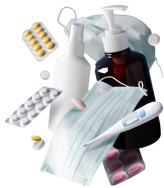-
Description
It contain; Pioglitazone and Metformin in its composition. Pioglitazone is a Thiazolidinedione antidiabetic medicine that decreases blood glucose by improving target cell response to insulin, without increasing pancreatic insulin secretion. Its action depends on the presence of insulin for activity. Pioglitazone is a strong and selective agonist for peroxisome proliferator-activated receptor-gamma (PPAR-gamma). Activation of these effects results in the production of a number of gene products that are involved in glucose and lipid metabolism. The interaction between Pioglitazone and these receptors result in the reduction in glucose levels, free fatty acids and decrease in tumor necrosis factor alpha, which is a chemical mediator of inflammation. This medicine has an advantage over others that it does not usually cause hypoglycemia when given alone (not with other hypoglycemic agents). Metformin (N, N-dimethylbiguanide) belongs to the biguanide class of antidiabetic drugs (containing two linked guanidine rings). This drug has a major clinical advantage in that it does not induce hypoglycemia or weight gain with remarkable cardiovascular safety. Metformin is also used for the treatment of polycystic ovary disease, diabetic nephropathy, and gestational diabetes. Metformin acts via both AMP-activated protein kinase (AMPK)-dependent and AMPK-independent mechanisms; by inhibiting mitochondrial respiration and inhibiting mitochondrial glycerophosphate dehydrogenase, and a mechanism involving the lysosome. Metformin acts directly or indirectly on the liver in order to reduce glucose production, and acts on the gut to increase glucose utilization. At the molecular level, metformin acts to inhibit the mitochondrial respiratory chain in the liver, which results in the activation of AMPK, enhances insulin sensitivity (via effects on fat metabolism) and lowers cAMP, and reduces the expression of gluconeogenic enzymes. Metformin shows AMPK-independent effects on the liver that results in inhibition of fructose-1,6-bisphosphatase by AMP.
-
Ingredients
Multivitamins and minerals
-
Dosage Form
Tablet
-
Uses
Diabetes Type 2
-
Dosage
Dose must be taken according to the doctor’s advice only; doses given below are suggested as supportive literature for better understanding in some areas of requirements. Adult dose: For diabetes type 2 the initial dose is 15mg Pioglitazone/500mg Metformin orally twice a day or 15mg Pioglitazone/850mg Metformin orally once a day. For patients with inadequate control on metformin monotherapy may initiate with 15mg Pioglitazone/850mg Metformin orally twice a day (depending on previous metformin dose). For patients with congestive heart failure the initial dose is: 15mg Pioglitazone/500mg Metformin or 15mg Pioglitazone/850mg Metformin orally once a day. Maximum dose is 45mg Pioglitazone/2000mg Metformin per day.
-
In case of Overdose
Overdose of this medicine may cause hypoglycemia, consult your doctor in case of overdose.
-
Missed Dose
In case you missed any dose, take the next dose as soon as you remember, but don't double your next dose to compensate for the missed one.
-
How To Use
Take it orally with water. All patients are advised to continue their recommended diet with an adequate distribution of carbohydrate intake during the day.
-
When Not to Use
Pioglitazone cannot be used in patients with symptomatic heart failure. Initiation of pioglitazone in patients with established New York Heart Association (NYHA) class III or IV heart failure is not recommended. Do not use in case of hypersensitivity to pioglitazone or any component of the formulation. Avoid the use of pioglitazone in serious hepatic impairment, active bladder cancer, history of bladder cancer, uninvestigated macroscopic hematuria and pregnancy. Pioglitazonis is not recommended for patients with type 2 diabetes mellitus planning to become pregnant. Metformin should not be used in case of hypersensitivity to the drug, metabolic acidosis, chronic heart, failure, myocardial infarction, diabetic ketoacidosis, severe renal disease, abnormal creatinine clearance resulting from shock, septicemia and lactation.
-
Side Effects
Increase in risks of bladder carcinoma May increase the risk of bone fractures Edema Upper respiratory tract infection Cardiac failure Headache Back pain Myalgia Constipation Sinusitis Pharyngitis Increased creatine phosphokinase in blood specimen Increased serum alanine aminotransferase Weight gain (probably due to fluid retention and weight gain)
-
Precautions & Warnings
Thiazolidinediones like; Pioglitazone which can cause congestive heart failure (CHF) in some patients. After initiating use of pioglitazone, and after increase in dose, observe patients carefully for signs and symptoms of heart failure (including excessive, rapid weight gain, dyspnea, and/or edema). If these signs and symptoms occur, manage the heart failure according to set standards of care. Discontinuation or reduction in dose of pioglitazone must be considered. Pioglitazone may cause ovulation (the release of an egg) in anovulatory (cause of infertility) premenopausal (woman's menstrual periods stop permanently) patients, and increases the risk of unintended pregnancy. Assess renal function prior to initiation of this drug. If metformin-associated lactic acidosis is suspected, general supportive measures should be taken in a hospital setting, along with immediate discontinuation of this medicine.
-
Food Interactions
Maitake (a mushroom) may increase the hypoglycemic (glucose/sugar lowering) effect of Pioglitazone. Avoid the use of grapefruit with Pioglitazone as it will increase the level or effect of pioglitazone oral by altering drug metabolism. Taking grapefruit along with this medicine could increase the accumulation of metformin in the liver and in result increases the risk of lactic acidosis. Taking metformin with a meal can reduce the chances of developing an upset stomach or gastric discomfort.
-
Storage/Disposal
Store below 25°C, at a dry place.
-
Laboratory Screening
If you are diabetic, go for the following tests: Glucose Tolerance Test, Blood sugar test, Blood Glucose Fasting Test. If you want to monitor your heart health then go for; ECG

